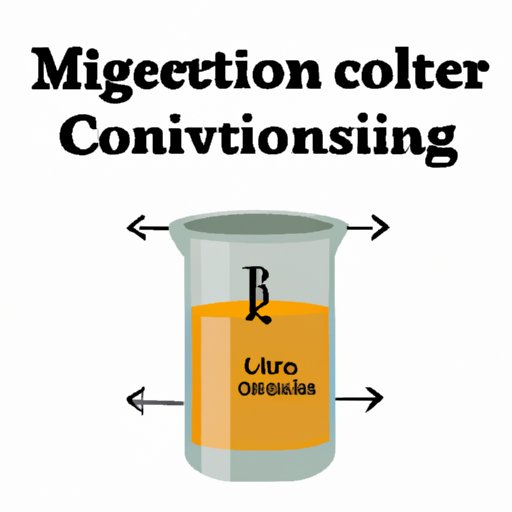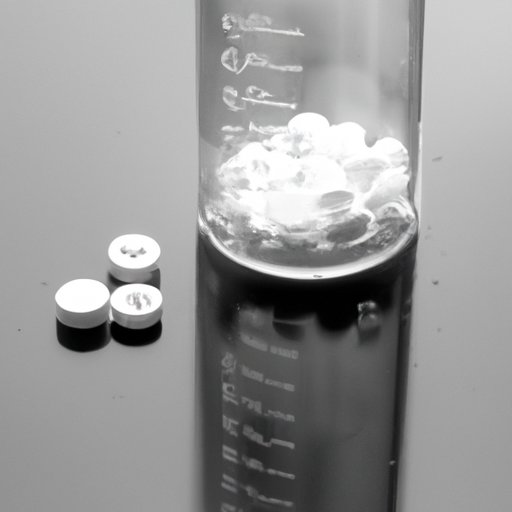Introduction
Medication administration is a complex process that requires accuracy and precision to ensure patient safety. One of the critical concepts healthcare professionals must understand is milligram to milliliter conversion. In this section, we will discuss the problem this article will solve and the importance of understanding milligrams to milliliters conversion for medication administration.
Explanation of the problem to be solved
Converting milligrams to milliliters is a common practice in medicine. Medications come in various dosage forms, such as tablets, capsules, and liquids. Healthcare professionals must be able to convert between milligrams and milliliters to calculate the correct dosage for each patient accurately. Failure to convert these values accurately can result in serious consequences, including over or under dosage, adverse reactions, and even death.
Importance of understanding milligrams to milliliters conversion for medication administration
Accurate medication administration is paramount in healthcare. Medical errors are a primary cause of patient harm and can even lead to death. Understanding milligrams to milliliters conversion is critical in calculating the precise dose of medication for patients. Healthcare professionals must be competent in converting milligrams to milliliters to ensure patient safety and reduce medication errors.
Brief overview of the article’s contents
This article will explore the relationship between milligrams and milliliters, the formulas for converting these values, and the importance of precision in medication administration. We will also provide a step-by-step guide for healthcare professionals to convert milligrams to milliliters and common pitfalls to avoid in the conversion process.

Understanding the Conversion: Milligrams to Milliliters Explained
Before diving into the conversion process, let’s define milligrams and milliliters.
Definition of milligrams and milliliters
A milligram is a unit of weight or mass. It is commonly used to express small amounts of medication or chemical substances. One milligram is equal to one-thousandth of a gram. A milliliter, on the other hand, is a unit of volume. It is used to express the amount of liquids or solutions, such as medication. One milliliter is equal to one-thousandth of a liter.
Explanation of the relationship between milligrams and milliliters
The relationship between milligrams and milliliters is based on the density of the substance. Density is defined as the mass per unit of volume. Therefore, the volume of a substance is directly proportional to its mass and density.
Examples of common medications that are measured in milligrams or milliliters
Healthcare professionals commonly administer medications that are measured in milligrams, such as pain relievers, antibiotics, and anti-inflammatory drugs. Liquid medications, such as cough syrups, antibiotics, and insulin, are measured in milliliters.
Calculating Accurate Dosages: Tips for Converting Milligrams to Milliliters
Now that we understand the basics of milligrams and milliliters let’s discuss why accurate dosages are vital in medication administration and how to convert milligrams to milliliters precisely.
Importance of accurate dosages in medication administration
Incorrect dosage can result in serious consequences such as medication toxicity, organ damage, life-threatening complications, and death. Therefore, accuracy is essential in medication administration. Healthcare professionals must ensure precise dosage calculations to guarantee the health and safety of their patients.
Tools and formulas for converting milligrams to milliliters
There are two formulas healthcare professionals can use to convert milligrams to milliliters:
Formula #1: Dose (mg) ÷ Concentration (mg/ml) = Volume (ml)
Formula #2: Dose (mg) × 1 ÷ Density (mg/ml) = Volume (ml)
Conversion tables or calculators can also aid in precise dosage calculations.
Examples of how to use these tools and formulas in real-world scenarios
Scenario #1: The patient requires 500mg of acetaminophen, and the medication is available in liquid form with a concentration of 160mg/5ml. How many milliliters should be administered?
Using Formula #1:
500mg ÷ 160mg/5ml = 15.625ml
Therefore, 15.625 milliliters should be administered.
Scenario #2: The patient requires 50mg of medication, and the density of the medication is 10mg/ml. How many milliliters should be administered?
Using Formula #2:
50mg × 1 ÷ 10mg/ml = 5ml
Therefore, five milliliters should be administered.
Mastering the Metric System: How to Convert Milligrams to Milliliters
The metric system is a decimal-based system of measurement used worldwide. Understanding the metric system is essential in precise dosage calculations. In this section, we will explore the metric prefixes used in milligrams and milliliters and provide a conversion chart for common milligram and milliliter values.
Brief history of the metric system
The metric system was first introduced in France in 1795 to standardize measurements across the country. It consists of base units, prefixes, and conversion factors. The metric system is used for scientific purposes and in the medical field worldwide.
Explanation of the metric prefixes used in milligrams and milliliters
The metric prefixes used in milligrams and milliliters are:
- kilo (k) = 1,000
- hecto (h) = 100
- deka (da) = 10
- base unit = 1
- deci (d) = 0.1
- centi (c) = 0.01
- milli (m) = 0.001
Conversion chart for common milligram and milliliter values
Using the metric prefixes and conversion formulas mentioned earlier, healthcare professionals can convert between different milligram and milliliter values easily. The following table presents some of the most common milligram and milliliter conversions.
| Milligrams (mg) | Milliliters (ml) |
|---|---|
| 1000 mg | 1 ml |
| 500 mg | 0.5 ml |
| 250 mg | 0.25 ml |
| 100 mg | 0.1 ml |
| 50 mg | 0.05 ml |
| 10 mg | 0.01 ml |
| 5 mg | 0.005 ml |
The Importance of Precision: Why Knowing Milligrams to Milliliters is Crucial for Medication Administration
As mentioned earlier, inaccurate dosage administration can have severe consequences. In this section, we will discuss the importance of double-checking dosage calculations before administration and communication between healthcare professionals to ensure dosage accuracy.
Explanation of the consequences of inaccurate dosage administration
The consequences of inaccurate dosage administration can range from mild to severe. Patients may experience adverse reactions, organ damage, and even death in severe cases. Reporting medication errors is crucial to ensure proactive prevention of future mistakes.
Importance of double-checking dosage calculations before administration
Double-checking dosage calculations before medication administration is a standard practice in healthcare. Two healthcare professionals should independently calculate the dosage and compare results to avoid medication errors. Verification is another critical step in ensuring that the right patient receives the correct medicine at the right time and in the right form.
Importance of communication between healthcare professionals to ensure dosage accuracy
Effective communication between healthcare professionals is essential in ensuring medication safety. Accurate medication administration requires collaboration between physicians, pharmacists, and nurses. Healthcare professionals must collaborate to ensure appropriate prescriptions, prepare accurate orders, and communicate patient medication history.
Converting Milligrams to Milliliters: A Comprehensive Guide for Healthcare Professionals
In this section, we provide a comprehensive guide for healthcare professionals on how to convert milligrams to milliliters accurately.
Overview of the article’s key conversion concepts
The key conversion concepts include the definition of milligrams and milliliters, the relationship between milligrams and milliliters, conversion formulas, and the importance of accuracy in medication administration.
Step-by-step guide for healthcare professionals to convert milligrams to milliliters
The following is a step-by-step guide for healthcare professionals to convert milligrams to milliliters:
- Determine the prescribed dose in milligrams (mg).
- Verify the concentration of the medication in milligrams per milliliter (mg/ml).
- Select a conversion formula based on the information above.
- Substitute the values into the chosen formula and solve for the volume in milliliters (ml).
- Double-check the dosage calculation before medication administration.
Common pitfalls and mistakes to avoid in the conversion process
Some common pitfalls and mistakes to avoid in the conversion process include incorrect concentration, incorrect decimal placement, calculation errors due to distractions, and misinterpretation of the prescription orders or medication labels. Healthcare professionals must be vigilant in preventing these errors and should not hesitate to ask for clarification if uncertain about a dosage or medication order.
The Ins and Outs of the Metric System: How to Convert Milligrams to Milliliters with Ease
Recap of the importance of milligram to milliliter conversion in medication administration
Accurate dosage calculation is of utmost importance in healthcare. Converting milligrams to milliliters accurately is essential in ensuring medication safety and reducing medication errors.
Final tips and tricks for mastering the metric system and accurate dosage calculations
Some final tips for mastering the metric system and accurate dosage calculations include practicing dosage calculation frequently, seeking help when uncertain, verifying calculations with a colleague, and using conversion tables or calculators. Understanding milligrams to milliliters conversion is a skill that takes time and practice, but it is an essential skill that healthcare professionals must master to ensure patient safety.
Conclusion
In conclusion, converting milligrams to milliliters is a critical concept for healthcare professionals. This article has provided an explanation of the problem this concept solves and the importance of understanding milligrams to milliliters conversion in medication administration. We also explored various formulas and tools for converting milligrams to milliliters, the importance of precision in medication administration, and the metric system’s basics. By following the provided tips and tricks and practicing frequently, healthcare professionals can master milligram to milliliter conversion and ensure accurate medication administration, thus improving patient safety and recovery.
